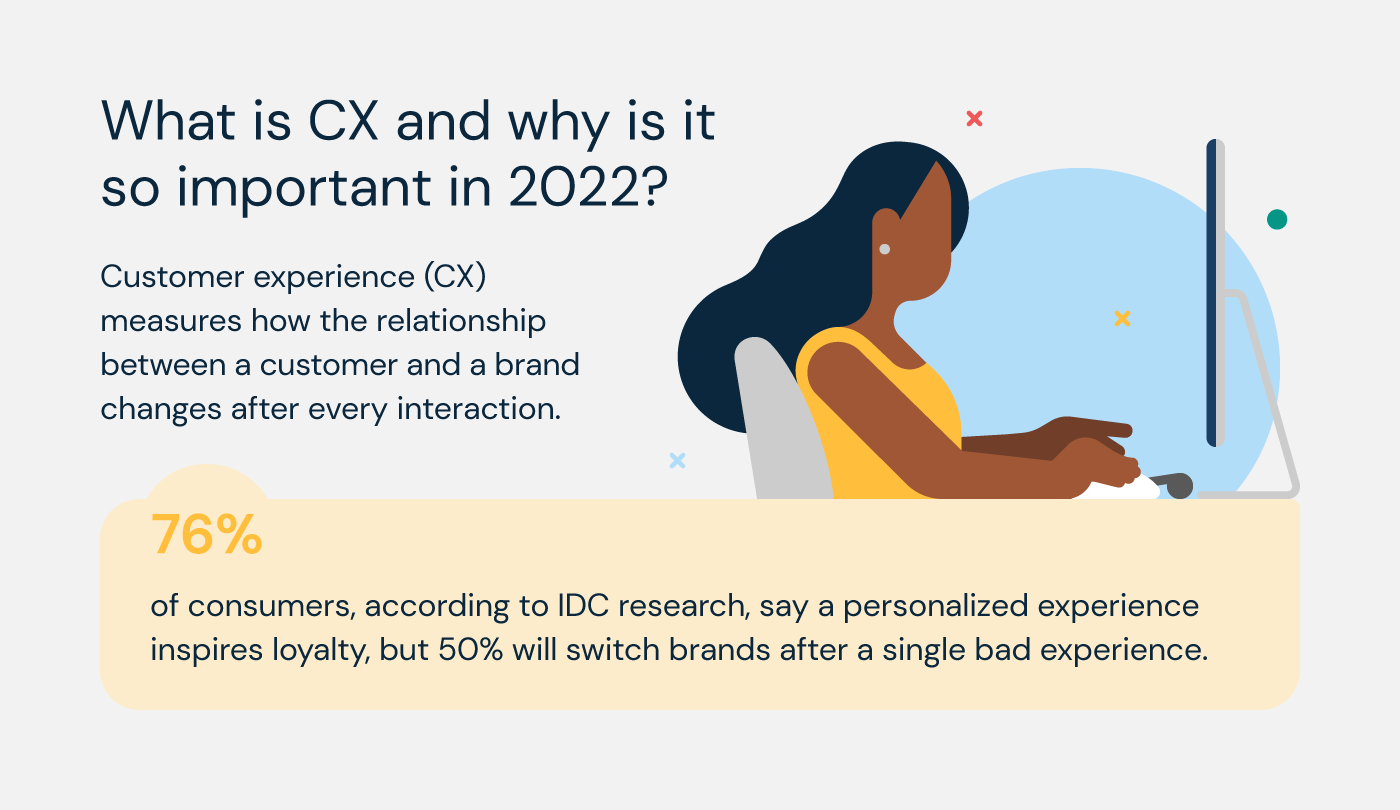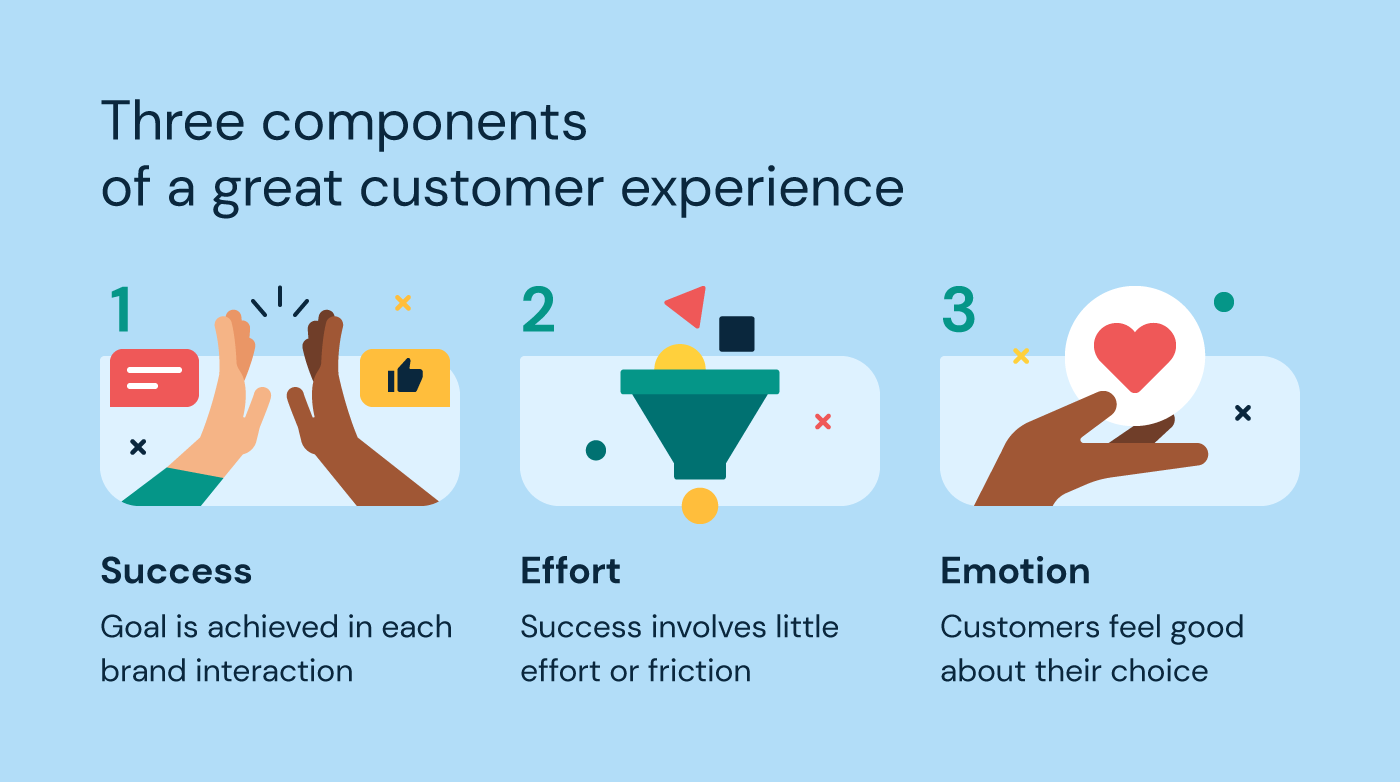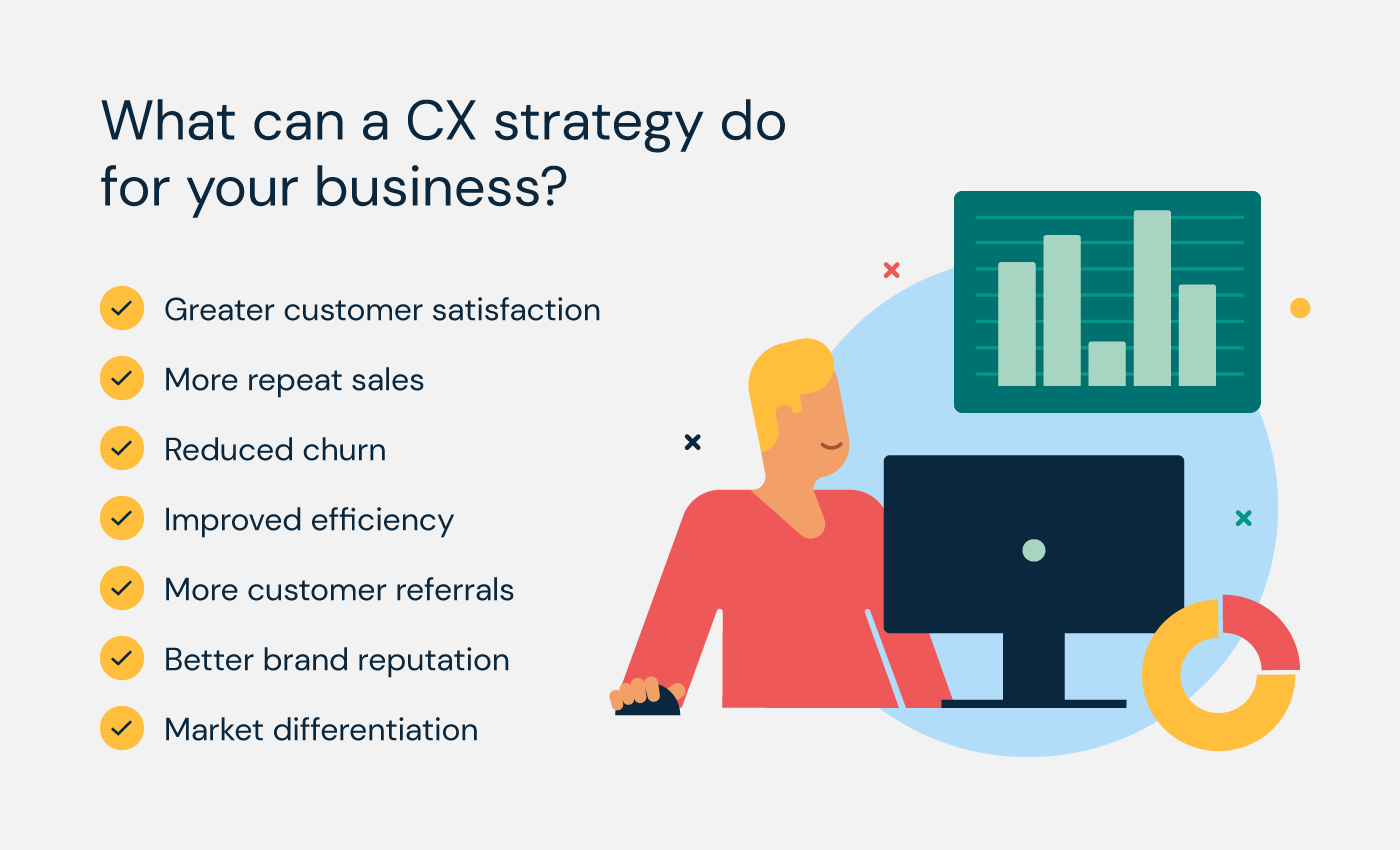In this article:
- What is the customer experience?
- Then, what’s a CX strategy?
- Benefits of top-notch CX
-
12 ways to deliver unforgettable customer experiences
- 1. Learn what customers really want by talking with them
- 2. Optimize for mobile experiences
- 3. Be available in every channel, but engage with customers in their channel
- 4. Provide support via mobile messaging
- 5. Make the entire customer journey frictionless
- 6. Harness the power of conversational AI
- 7. Build rapport with customers through rich messaging
- 8. Be there for customers anywhere in the world
- 9. Get personal with in-app video calling and video messages
- 10. Make verification secure, easy, and reliable
- 11. Set engagement goals and monitor progress
- 12. Find a partner to accelerate your CX transformation
Although we’re not living in the Metaverse quite yet, who could have predicted the rapid digital transformation over the past few years? Today, new technologies allow us to skip waiting rooms and see a doctor via video, talk with a financial advisor about our retirement plans through live chat, and still have plenty of time in the day left to get groceries delivered for dinner!
Businesses should be applauded for providing the exceptional convenience we now take for granted, but with that comes higher consumer expectations. Today’s customers won’t settle for subpar experiences, and business leaders have taken notice. To stay ahead of the competition, forward-looking enterprises are searching for ways to use technology to improve customer experience (CX).
That’s no small task, to be sure. But if you’re interested in future-proofing your organization, then you’ve come to the right place. We’ll explore how prioritizing the customer relationship at every turn can be an organization’s greatest asset, and we’ll offer 12 surefire ways that businesses can upgrade their communication to attract, delight, and retain their customers.
What is the customer experience?

Customer experience measures how a customer feels about their relationship with a brand throughout their entire purchasing journey. Each interaction a customer has with a business can influence their experience - which often begins well before a buying decision is made.
A customer’s reaction to seeing a brand’s online or offline advertisements, or how satisfied they feel after sales or support interactions, are just a few examples of CX.
Then, what’s a CX strategy?
A CX strategy is a holistic approach to providing exceptional service and satisfaction for customers at every touchpoint. While that sounds pretty neat, what does it actually mean?
For consumers, a successful CX strategy means they get:
- Personalized treatment from a business that cares about and values them
- Unique and memorable shopping experiences
The goal is for the customer to successfully get whatever they need when interacting with a brand.
Whether buying something, contacting customer support, or asking for a product update - they get what they come for and their day is brightened by their interaction with the brand.
The three pillars of a successful CX strategy

A customer experience strategy is built on three pillars: success, effort, and emotion.
Success: Whatever the intention, the customer’s needs must be satisfied. For example, if a customer calls support and has their questions answered, the interaction was successful.
Effort: How easy was it for the customer to achieve their goal? For CX-minded organizations, reducing friction and removing obstacles should help the consumer enjoy success with as little effort as possible.
Emotion: Will the customer think positively about their interactions with a brand? Emotion builds off the customer’s initial motivation for picking a product or service. Did they get a good price? Exceptional customer service? Promotional benefits? No matter their reason for choosing a brand, the customer needs to receive that and more to feel good about their choice.
For companies to nail this strategy, good customer service needs to be in its brand DNA. From marketing to sales to development to support, each team member should be aligned on a single mission: adding value every time a consumer comes in contact with the brand.
Before we get into specifics about how organizations can make that happen, let’s first discuss all the ways it pays off for businesses to make great CX their #1 objective.
Benefits of top-notch CX

So, why would businesses prioritize CX as a strategy? Because, when customers feel good about their experiences with a brand, they’re more likely to keep coming back - and bring their friends with them!
Who knows what will happen tomorrow? To protect against unpredictable changes in the business landscape, an organization’s best insurance policy is focusing on what they can control: how well they provide customer care, convenience, and value.
When done well, companies should expect to see:
- Greater customer satisfaction and loyalty
- More sales or repeat business
- Improved service and operational efficiency
- Positive word-of-mouth advertising by customers
- Enhanced brand reputation that’s synonymous with customer care
- Market differentiation from competitors
Are there any industries that wouldn’t benefit from prioritizing their customers’ experiences? From retail to e-commerce to banking to health care, what better way to stand out from competitors than through a customer-centric approach to doing business?
However, developing the best possible CX takes commitment from organizations willing to go the extra mile for their customers. After all, if it were easy, everyone would do it.
If you’re interested in taking the next step, here are the 12 best ways to get started.
12 ways to deliver unforgettable customer experiences

These are the top tools and strategies organizations can use to start improving their CX today.
1. Learn what customers really want by talking with them
From email promotions to targeted pay-per-click advertisements, brands spend a lot of time and energy trying to engage with customers every day. But how many of those attempts at contact offer something valuable or relevant to the target audience?
Instead of flooding customers with communication, companies that take the time to understand their customers can stand out in a crowded market.
How? After developing customer personas, brands can send questionnaires via SMS to find out:
- Which conversational channels are consumers moving to?
- What’s driving their choices to buy?
- Where and how do they want to make a purchase?
- What do they really value in a brand?
Once businesses know these answers, they have a picture of what good service looks like for their customers and can tailor their offerings to get customers what they need, when they need it.
2. Optimize for mobile experiences
Mobile messaging campaigns are a great way to reach customers wherever they are the moment they need help. Consider some of these highly personalized, valuable interactions that brands can use on mobile:
-
A notification about an upcoming appointment
-
A reminder about items left in an online shopping cart
-
An alert about an unusual transaction
-
A personalized message about a coupon or discount
A person’s mobile is near and dear to them - so it’s important that product managers make sure mobile CX is optimized to send relevant and useful messages.
3. Be available in every channel, but engage with customers in their channel
A customer-centric approach means meeting customers on their terms, including in their preferred channel. How’s that possible? With omnichannel delivery that combines online and offline company messaging.
No matter the channel, customer engagement solutions can help brands offer their customers true one-to-one experiences with interactive messaging campaigns and personalized conversations.
Customers get the relevant content they want, where they want it. Best of all? Whether through email, text, voice calls, or social media, customers have the power to take action how they see fit.
Doesn’t that sound like an easy path to a satisfying outcome for the customer?
4. Provide support via mobile messaging
Research from Sinch shows that a majority of consumers want to have two-way conversations with brands via messaging channels and apps. Customers crave rich conversations, so brands should find tools to help them deliver the right messages at every stage.
With tools like Contact Pro that enable chats with live agents, customers can connect with brands over their favorite messaging channels at any stage of the customer journey. Chat support empowers customers to feel in control of the conversation while enjoying the speed and convenience of real-time messaging.
5. Make the entire customer journey frictionless
With hundreds, thousands, or even millions of customers, how can organizations be sure that they’re satisfying everyone? Well, with the right solution, brands can scale without sacrificing the personal touch.
Comprehensive customer journey management makes managing messaging campaigns and one-to-one customer interactions possible at a massive scale.
From the first customer to the one-millionth, brands can use data-driven insights to give personalized content and guidance at any stage of the buying journey.
Brands can also integrate omnichannel messaging to have continuous conversations with customers from channel to channel without disruption.
What’s the end result? A truly frictionless journey, where every interaction is relevant, helpful, and easy for the customer.
6. Harness the power of conversational AI
What if a single tool could streamline customer support and help customers make purchases more easily? With a conversational messaging application programming interface (API), that’s not hypothetical!
With one simple API integration, organizations can:
- Reach customers over multiple channels and deliver a mobile-first experience
- Build stronger customer relationships on their preferred apps
- Reduce the barriers to purchase by offering personalized advice when customers have questions
- Eliminate long phone waiting times
- Optimize messages for individual channels\
Conversational AI can create the ultimate seamless customer journey by supercharging organizations’ messaging capabilities.
7. Build rapport with customers through rich messaging
Mobile messaging helps brands nurture the relationships they have with their customers. While text campaigns are a popular way of making contact, what if there were a way to enhance outbound messaging at scale?
Rich SMS enables brands to create and send fully personalized and interactive messaging campaigns that stand out in a crowded digital space.
With compelling, tailored offerings, brands can deliver personalized and memorable experiences that meet customer expectations and drive engagements that build lasting relationships.
8. Be there for customers anywhere in the world
Most brands would love to be there for customers 24/7, but is that possible if they have a worldwide audience? Yes!
Tools like Chatlayer can actually help brands cross geographic, language, and time barriers with always-on customer support that doesn’t sacrifice the personal touch!
Automated customer support also delivers quick and effective human-like, personalized voice bot and chatbot conversations that can keep customers engaged 24/7.
9. Get personal with in-app video calling and video messages
Personalized email, messaging, and notifications can help the customer along their journey in most situations. But what about more complicated questions that need more face time?
With in-app video calling, brands can offer a customizable video chat experience in mobile, web, or desktop applications that builds deeper connections.
Regardless of the channel or device, in-app video software development kits (SDKs) can deliver high-quality live video chats that drive engagement.
10. Make verification secure, easy, and reliable
Digital interactions are the future of customer convenience, but customers shouldn’t need a “leap of faith” to share their personal data with a business.
How likely is a person to give their credit card number, or address, to a stranger on the street? Not very.
Similarly, customers need to know they can trust brands to protect their private information before they continue on their buying journey.
Luckily, brands can give their end-users peace of mind at every stage by sending a simple text message. With tools like text verification, organizations can send customers one-time passcodes via SMS for sign-up, login, or transaction approvals.
In addition to verifying customers securely and at scale, these humble (yet powerful) messages secure a good user experience and help:
- Increase conversion rates
- Boost revenue
- Reduce churn
- Prevent fraud
11. Set engagement goals and monitor progress
How can an organization measure if its CX strategy is successful? By setting goals and measuring them with Key Performance Indicators (KPIs).
Custom journey optimization can help track the most important KPIs in CX management, which include:
- Churn: the rate at which customers cancel services or subscriptions
- Upselling: how many customers have increased their contracted packages (and by how much)
- Cross-selling: the rate at which customers add another relevant service/product to their initial purchase
- Retention: the number of customers who had an option to cancel services but opt to remain
- Checkout abandonment: the rate at which customers don’t complete a purchase
- Net Promoter Score (NPS): measures customer satisfaction with products, services, and the company
- Multichannel touchpoints: the flow of customer interactions within communication channels; shows popular channels and potential bottlenecks
12. Find a partner to accelerate your CX transformation
Rather than sourcing different vendors, a dedicated CPaaS partner like Sinch can provide all the tools, integrations, and insights that brands need to improve customer experience.
Find out how our robust and innovative solutions have helped organizations like Sureshot strengthen their portfolio with global messaging and omnichannel reach, or get in touch with an agent today to learn more!




